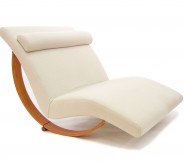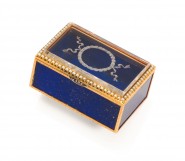Lot #6 - Lin (William Mclintock) Onus
-
Auction House:Mossgreen
-
Sale Name:Fine Australian & International Art
-
Sale Date:23 Nov 2015 ~ 6.30pm
-
Lot #:6
-
Lot Description:Lin (William Mclintock) Onus
(1948-1996)
Early Morning Reflections, Barmah
synthetic polymer paint on canvas
121.5 x 182.5 cm
signed lower right: Lin Onus -
Provenance:Acquired directly from the artist; Thence by decent; Private collection, Melbourne
-
References:Related Works: Barmah Forest 1994, Australian Heritage Commission Collection
-
Notes:In the sad litany of early deaths in the Australian indigenous community, none was more distressing for the contemporary art world than that of Lin Onus at the age of 47. A charismatic, articulate and socially aware man, Onus used his art as a platform through which he sought to reconcile the duality of his Scottish and Aboriginal heritage. Onus was born into a middle class family in the comfortable Melbourne suburb of Deepdene; however, this family was quite unlike its neighbours. Lin's father Bill was a Yorta Yorta man from Cummeragunja near Echuca on the Murray River, an area now known as the Barmah National Park. He was also a foundation member for the Aborigines Advancement League in Victoria and met his future wife, the Scots-born Mary McKlintock Kelly, after she was crowned 'Miss Communist Party 1947'. In 1952, Bill Onus launched Aboriginal Enterprises from a shopfront in Belgrave where he 'offered a wide range of merchandise: bark paintings from Arnhem Land and locally made artefacts, furniture, textiles and pottery decorated with motifs from traditional Aboriginal art. With additional branches (in Victoria and South Australia) Bill Onus provided employment and training and fostered a great sense of cultural pride among a new generation of urban Aborigines.'1 It was an extraordinary atmosphere to grow up in and the young Lin went on many holidays with his father to Cummeragunja where he would hear 'stories told by his uncle Aaron Briggs, known as 'the old man of the forest'. It was Aaron Briggs who gave him his Koori name, Burrinja, meaning 'star'. They would sit on the banks of the Murray River within view of the Barmah Forest, Onus' spiritual home, the subject of many of his later paintings and his final resting place.'2 Essentially self-taught as a painter, Onus developed a nuanced and highly refined skill in a hyper-realist style. In this, he acknowledged the debt he owed to previous indigenous artists who worked in the western mode of landscape, figures such as Albert Namatjira and Ronald Bull. Onus also gleaned from the non-indigenous, citing Eugene von Guerard, the illustrator Ainslie Roberts, and the early works of Sidney Nolan and Albert Tucker as being highly influential. His own early paintings were often emotively charged, drawing on the graphic style of comics for their impact but these were countered by contemporaneous vistas of the Barmah Forest, its wetlands and majestic stands of River Red Gums. In the late 1980s, Onus travelled to Maningrida in the Northern Territory, befriending the senior artist and lawman Jack Wunuwun who 'adopted Lin and his family into traditional Yolngu kinship system. He taught Lin about Yolngu culture, gave him a 'skin' and a personal name, made him his son and gave him traditional designs he could paint. .... Lin was so excited about the new way of painting that Jack Wunuwum had given him that he began his new style, incorporating traditional rarrk [cross-hatching] into western realist paintings. At last, Lin, by using both black and white elements in his art, was painting what he was: a 'yella fella', and making it beautiful, something he could be proud of.'3 Prior to these events, Onus had painted the Barmah forest fenced off from the viewer by cyclone wire (Fences fences fences 1985, private collection) but soon after, the wire was blatantly replaced with a grid of rarrk (Jimmy's Billabong 1988, National Gallery of Australia). In Early Morning Reflections, Barmah however, we find a less confrontational vision of Onus' personal Dreaming, one that invites 'dialogue with a brand of wit and panache that (relies) for its impact on inclusion rather than alienation.'4 Painted in the artist's signature mature style, the scene becomes a metaphor for contemporary indigenous / non-indigenous life, where the water's reflective surface acts as a compositional divide between the 'seen' and the 'unseen.' Under the surface, in a post-modernist twist, a creep of tortoises bearing rarrk swim in horizontal formation echoing a similar motif employed by Japanese artists when painting images of koi fish, a format which Onus first encountered whilst artist-in-residence at the Fujin Kaikan Centre in Yokohama in 1989.5 1 Kleinert, S., 'Onus, Bill', Kleinert, S. and Neale, M., The Oxford Companion to Aboriginal Arts and Culture, Oxford University Press, Melbourne, 2000, p.666 2 Neale, M., Urban Dingo: the art and life of Line Onus 1948-1996, Craftsman House, Sydney, 2001, p.14 3 Neale, M., op cit., p.122 4 Onus, L., artist statement, 1990. Quoted in Neale, M., 'Lin Onus', Artlink, vol.20 no.1, 2000 5 Leslie, D., Aboriginal art: Creativity and Assimilation, Melbourne, Macmillan Art Publishing, 2008, p.244
-
Estimate:A$200,000 - 300,000
-
Realised Price:
-
Category:Art
This Sale has been held and this item is no longer available. Details are provided for information purposes only.










